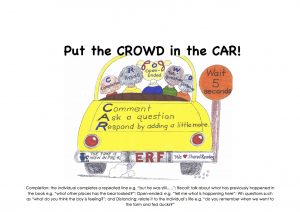Shared reading is a collaborative learning activity that emulates and builds on the bedtime book experiences that many children and parents have together. The focus during shared reading is on the interaction. Shared reading is appropriate for any emergent reader, no matter their age and can be done individually or in small groups.
Focus on Interaction
Shared reading allows adults to model vocabulary and language, relating to both the book and to the individual’s life. It is a great activity for teaching an individual how to interact around books and about the structure and rules of conversation. It is also a very enjoyable experience!
Build Concepts about Print and Language
Shared reading is an ideal opportunity for teaching individuals about books and how they work, and for demonstrating concepts about print. It helps students to understand the function of some of the literacy skills that they will need to develop later as they move along their literacy journey.
Repeated readings of books during shared reading works to build these print concepts, as well as building vocabulary, language and interaction skills.
What Should I Do When Reading?
The CAR strategy (Notari‐Syverson, Maddox, and Cole, 1999) encourages adults to support students during shared reading by ‘following the car’:
- Comment on what the student is doing e.g. “Oooh, a dog” (then wait 5 seconds)
- Ask a question e.g. “Do you like the dog?” (then wait 5 seconds)
- Respond by adding more e.g. “I like the dog. He looks very friendly”.
You can also focus on print concepts, such as talking about text versus pictures, pointing out the title, the beginning and ending of the books and supporting the individual to turn pages. Sometimes when you are reading, point word-by-word as you read to help the development of other print concepts.
Use the Crowd in the Car poster by Corinne Watson to prompt you to use a range of questions and comments in shared reading.
And don’t necessarily expect every individual to attend or be interested in every book right from the beginning – the more you do shared reading, the more they discover about the sorts of books they like and the more they learn about how exciting books can be, the more engaged they will be during this time.
Building Language and Communication
One of the aims of shared reading, is to build language and communication skills. If the individual participating in shared reading has complex communication needs, make sure you use their Augmentative and Alternative Communication system during this time. Model all parts of “Comment, Ask, Respond” using aided language stimulation. The best way to build language and communication skills is to show the individual how they could use their own “voice” to do this. A comprehensive communication system, such as PODD or core vocabulary, allows you to model a wide range of language and communicative functions.
Shared Reading with PODD.
What Books Should Be Used for Shared Reading?
The best books for shared reading are those that an individual engages with and enjoys. It’s important to expose each individual to a range of books so that they can figure out the sorts of books they most enjoy. Think about including books with repeated lines, books with basic sentence patterns, books with imagination, poetry books, and books with rich storylines. Alphabet books, books of songs, books with favourite characters, counting books and books about their favourite topics should also be included. Books with rhyme and rhythm can help to build phonological awareness – so make sure you include these too! And it’s important to remember that some individuals prefer non-fiction and/or photo based books.
Custom books may also be a good option – for many individuals books written about them and their favourite people and places are highly motivating and engaging.
Shared Reading of some custom books using the Core Vocabulary user in Proloquo2Go v3 (there would be a lot less navigating with Proloquo2Go v4)
Thanks to students and staff who appear in the videos and photo.
For more information
Check out the Shared Reading Module on the Dynamic Learning Maps site.
And to download this information as a handout, click here.



Margie Anderson
jane
Caitriona Tynan
jane
Pingback: Comprehensive Literacy Instruction: Meeting the Instructional Needs of ALL Students in our Classrooms | Jane Farrall Consulting
Pingback: ASSERT Communication and Literacy Conference 2017 | Jane Farrall Consulting
Pingback: Shared Reading – Keep the Interaction Going! | Jane Farrall Consulting
Pingback: AAC modeling: Ms Petersen story time | Ms. Petersen, SLP